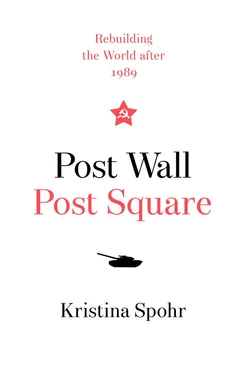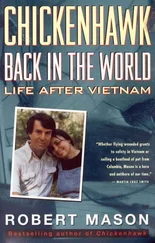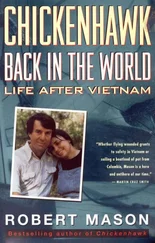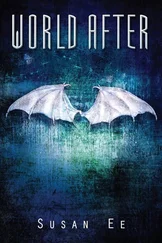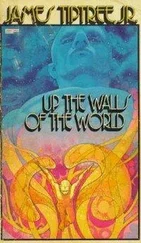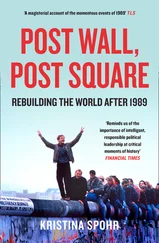Both Bush and Gorbachev hoped that this new modus vivendi could serve as the foundation for post-Cold War international relations. America was clearly the senior partner but the cooperation was real. The partnership worked, but it was fragile, precisely because it was overly focused on the relationship between the two men at the apex of their respective states. Bush, Kohl and other Western leaders all clung to Mikhail Gorbachev rather than engaging with the deeper problems of the unravelling Soviet Union. At the end of 1991, the USSR totally disintegrated, forcing Bush to take seriously the man at the helm of post-Soviet Russia, Boris Yeltsin – who was struggling to confront the immense challenge of his country’s transition to capitalist democracy. [14]This new upheaval in global geopolitics, affecting not only Europe but also Asia, obliged Bush to rethink his two-pillar approach.
With the Soviet Union gone and bipolarity a thing of the past, the United States was now pressing with fresh urgency for a truly global US-led free-trading system. Intended to replace the almost moribund 1947 General Agreement on Tariffs and Trade (GATT) which no longer seemed adequate to the dynamics of an increasingly globalised world economy, a new World Trade Organisation should embrace the big players Russia and China as they moved out of their respective command economies or ‘Plans’, and offer more support to the developing countries. Yet the US was not alone in seeking to reposition itself in the global economic power play. Japan, with its prodigious economy, was touted as the coming hegemon of the ‘Pacific Century’, whose economic weight would fill the geopolitical vacuum created by the collapse of the Soviet Union. The leadership of communist China had its own ambitions. The Chinese regime survived ‘the Tiananmen Incident’, consolidated its hold on the country and prospered post-Square; over time this would prove far more important, both economically and geo-strategically, than the false dawn of the Rising Sun. [15]
In Europe, too, the peace and stability of the post-war era were starting to fray in 1991 when Yugoslavia became engulfed by a genocidal war. A once firm Balkan polity fractured into warring statelets, triggering massive movements of refugees. These new Balkan wars did not ignite a European or global conflagration, as in 1914, but international leaders struggled to put out the flames. [16]
The splintering of Yugoslavia also raised fears of what Gorbachev himself called the ‘Balkanisation’ of the Soviet Union in 1991. [17]For a while Moscow’s power struggle with Kiev over territory in Ukraine and Crimea seemed even to teeter on the edge of war. Disputes and clashes erupted during 1992 about ownership of the Black Sea Fleet and strategic ports, Russian basing rights and the use of Ukrainian military facilities. And Washington was particularly anxious about the fate of the Soviet nuclear arsenal – now scattered between Russia and three other newly independent post-Soviet republics.
The collapse of Soviet power allowed former clients around the world to assert themselves as ‘renegade’ states. Even after the Kuwait War of 1990–1, the problem of Saddam Hussein’s Iraq remained unresolved, and Kim Il-sung’s North Korea, with its secret nuclear weapons programme, now became a particular headache. [18]This is why the last two chapters of Post Wall, Post Square are devoted to global events in 1992 – a year largely ignored in most accounts of the end of the Cold War, in which problems were spawned that are still with us in the twenty-first century. Notwithstanding the premature triumphalism of some commentators, the Cold War did not end with the simple victory of the United States over the Soviet Union, and the world was not remade in America’s image. [19]
Nowhere did international diplomacy produce swifter and more impressive results than in the unification of Germany. The German question posed a huge challenge because of the country’s problematic place in Europe, its centrality to the origins of two world wars and its subsequent position as the cockpit of the Cold War. In the process of managing German unification, two key alliances of the West during the Cold War – NATO and the European Community – were conserved, modified and eventually enlarged to encompass the states of Central and Eastern Europe. [20]
The measures adopted to stabilise post-Wall Europe were thus essentially conservative in character, in the sense that they made use of pre-existing, Western institutions and structures, rather than custom-designing new ones to meet the exigencies of a new era. Despite the efforts of some European statesmen – notably Genscher, Gorbachev and Mitterrand – in 1989–91, no new pan-European architecture was created to embrace the two halves of the continent and incorporate Russia into a shared security structure. The Helsinki 1975 Conference on Security and Cooperation in Europe (CSCE) possessed the potential to become such a structure, but it was never converted into an operative security organisation. The post-Wall political reality – with America set to remain a ‘European power’ – conspired against such pan-European paths. And the attractions of a Europe reunified under the aegis of an ever-closer European Union and secured by a reinvented NATO were simply too strong. [21]
Consequently, the West–East asymmetry increased over time, as the jumbled fragments of what had been the Cold War order were re-formed within an ever-larger Western-dominated framework. The resulting imbalance would become intolerable for Gorbachev’s successors, Boris Yeltsin and Vladimir Putin. A marginalised – though still powerful and status-conscious Russian rump state – was left to lick its wounds on the periphery of the new Europe. We are still grappling with the consequences. [22]
This rereading of the period 1989–92 draws on archival material in various languages from both sides of the former Iron Curtain. Post Wall, Post Square relies heavily on recently declassified or neglected documents – ranging from memoranda to memcons, from personal letters to intelligence reports – in the national, presidential and Foreign Ministry archives of the United States, the Soviet Union (Russia), Germany, Britain, France and Estonia. Other important resources include the National Security Archive, the Woodrow Wilson Center Digital Archive and the associated Cold War International History Project in Washington DC – with their abundance of electronic briefing books and published documentary collections from the West, Eastern Europe, Russia and China (including party and Politburo materials). Further primary sources include diaries and private papers by the leaders and their advisers and numerous memoirs by the major actors. [23]
Post Wall, Post Square combines the granular reconstruction of key episodes with the synoptic study of macro-historical change. To comprehend properly this era of transitions requires us to adopt an artificial vantage point ‘above’ the confusion of events. But a successful analysis must also find space for the narratives with which leading protagonists made sense of their world and justified their actions. After all, the story of what happened in those years was ‘co-written’ by the chief actors. They were never just players in someone else’s tale, but powerful, if flawed, makers of history in their own right.
In 1995 German president Roman Herzog characterised his era as ‘a time that as yet has no name’. [24]Twenty-five years later, his aphorism has lost little of its poignancy, because the distinguishing features of the post-Cold War era remain difficult to discern or understand. Some may say, as 1989 recedes into the past, that the overarching narrative must be economic – taking us from the collapse of the Bretton Woods financial system in the 1970s to the financial crash of 2008. [25]But I argue that a deeper analysis of these crucial ‘hinge years’ of 1989–92 helps to make sense of the underlying geopolitical order in which the upheavals of global capitalism take their place. And it is this order that is now under threat.
Читать дальше
